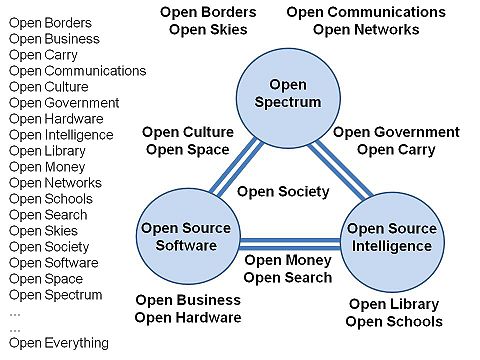Autonomous Internet Road Map: Difference between revisions
| Line 139: | Line 139: | ||
** forking & merging (evolutionary principles produce evolved/ evolveable code) | ** forking & merging (evolutionary principles produce evolved/ evolveable code) | ||
** access for all (affordability, geolocation, peak times, bottlenecks, etc.; a political AND technical problem) | ** access for all (affordability, geolocation, peak times, bottlenecks, etc.; a political AND technical problem) | ||
* From [[Richard Adler]] | * From [[Richard C. Adler]] | ||
** a metadata-ready environment, perhaps embracing something akin to RDF/XML style metadata schema (or other schema that will prove appropriate on the data level(s) of the next net) | ** a metadata-ready environment, perhaps embracing something akin to RDF/XML style metadata schema (or other schema that will prove appropriate on the data level(s) of the next net) | ||
* From [[Aaron Huslage]]: | * From [[Aaron Huslage]]: | ||
Revision as of 02:42, 3 March 2011
Introduction
Our preliminary focus is on the Open Source Tri-Fecta, the combination of Free/Open Source Software (F/OSS), Open Spectrum, and Open Source Intelligence (OSINT), with an urgent collective commitment to focusing on the vital need to connect the three billion poorest of the poor as quickly as possible. Connectivity and Interoperability of machines and content, are the Prime Directives.
Google Group: Building a Distributed Decentralized Internet
Socio-political
Spectrum Commons
Open and Free Internet Advocacy
Identity
Legal
Resources
Strategic Approaches
Connecting Humanity
Technical Terms of Reference
Financial Objectives
Operational
Empowering the Billions of Poor
Open Source Foundation Technical Map
Financial Possibilities
Tactical
Pilot Projects
Important Gaps in Open Capability
Financial Needs
Technical Infrastructure
The OSI Model
"The Open Systems Interconnection model (OSI model) is a product of the Open Systems Interconnection effort at the International Organization for Standardization. It is a way of sub-dividing a communications system into smaller parts called layers. A layer is a collection of similar functions that provide services to the layer above it and receives services from the layer below it. On each layer, an instance provides services to the instances at the layer above and requests service from the layer below."
| OSI Model | ||||
|---|---|---|---|---|
| Data unit | Layer | Function | ||
| Host layers |
Data | 7. Application | Network process to application | |
| 6. Presentation | Data representation, encryption and decryption, convert machine dependent data to machine independent data | |||
| 5. Session | Interhost communication | |||
| Segments | 4. Transport | End-to-end connections and reliability, flow control | ||
| Media layers |
Packet | 3. Network | Path determination and logical addressing | |
| Frame | 2. Data Link | Physical addressing | ||
| Bit | 1. Physical | Media, signal and binary transmission | ||
"Some orthogonal aspects, such as management and security, involve every layer." [1]
Autonomous Internet Models
(this section will detail multiple models for Autonomous Internet architectures)
P2P Infrastructure
Physical Layer
A minimum of 3 satellites are required for global communications. More is better to prevent bottlenecks. Physical connections, wires, cables, are another layer in the system.
Transport Layer
Router Layer
Nodes on the networks have multiple addresses.
Host Layer
Nodes on the networks have multiple addresses. Nodes on the networks implement multiple communication protocols.
Application Layer
Nodes on the networks implement multiple communication protocols. Software on the network will implement APIs for interoperability. Good APIs will provide mechanisms for automated discovery and communication.
Required resources for implementation
Open Everything Overview
Below is a depiction of a simplified view of Open Everything at the strategic level. Our early focus is on the Open Source Tri-Fecta, the needed combination of Open Source Software, Open Spectrum, and Open Source Intelligence.
Discourse
Collaboration around defining Core Principles
- From Paul Hartzog:
- interoperability first
- inclusive (give all ideas a chance)
- diversity (many solutions trump any single solution)
- cooperation-oriented (populations of cooperators outperform defectors in complex systems)
- test-driven development
- forking & merging (evolutionary principles produce evolved/ evolveable code)
- access for all (affordability, geolocation, peak times, bottlenecks, etc.; a political AND technical problem)
- From Richard C. Adler
- a metadata-ready environment, perhaps embracing something akin to RDF/XML style metadata schema (or other schema that will prove appropriate on the data level(s) of the next net)
- From Aaron Huslage:
- a Content-neutral and content-centric environment.
- user-centered design
Open Questions
- On quora.com:
- What are the fundamental requirements and building blocks of a distributed internet? in preparation for the Contact summit in NYC october 20 (2011), we want to understand the current landscape of projects/initiatives building a distributed internet and the fundamental requirements so we can better coordinate efforts
- Aaron Huslage on The Next Net Google Group, thread "Too Geeky?":
- There are some major issues with the technology stuff we talk about. It's largely too geeky. This is normal for new technology since the developers and early adopters are practitioners of geekery, but I worry about things when they get to grandma and grandpa. "Normal" people don't know how to use BitTorrent or port forward their router, for instance, so how can they participate in one of the many p2p networks in existence today? "Normal" people don't even know they HAVE a router, they take what the telco gives them and call them when it breaks. "Normal" people don't even know what a web browser is, they simply click the little Internet icon on their desktop and are whisked away to a world where everything is peaceful and amazing. See what I mean? What implications does a distributed Internet have for users? How do we make this stuff EASY and as fully baked as possible?
"Greenfield" Visioning
References
- ↑ Source of quote and table: http://en.wikipedia.org/wiki/OSI_model
